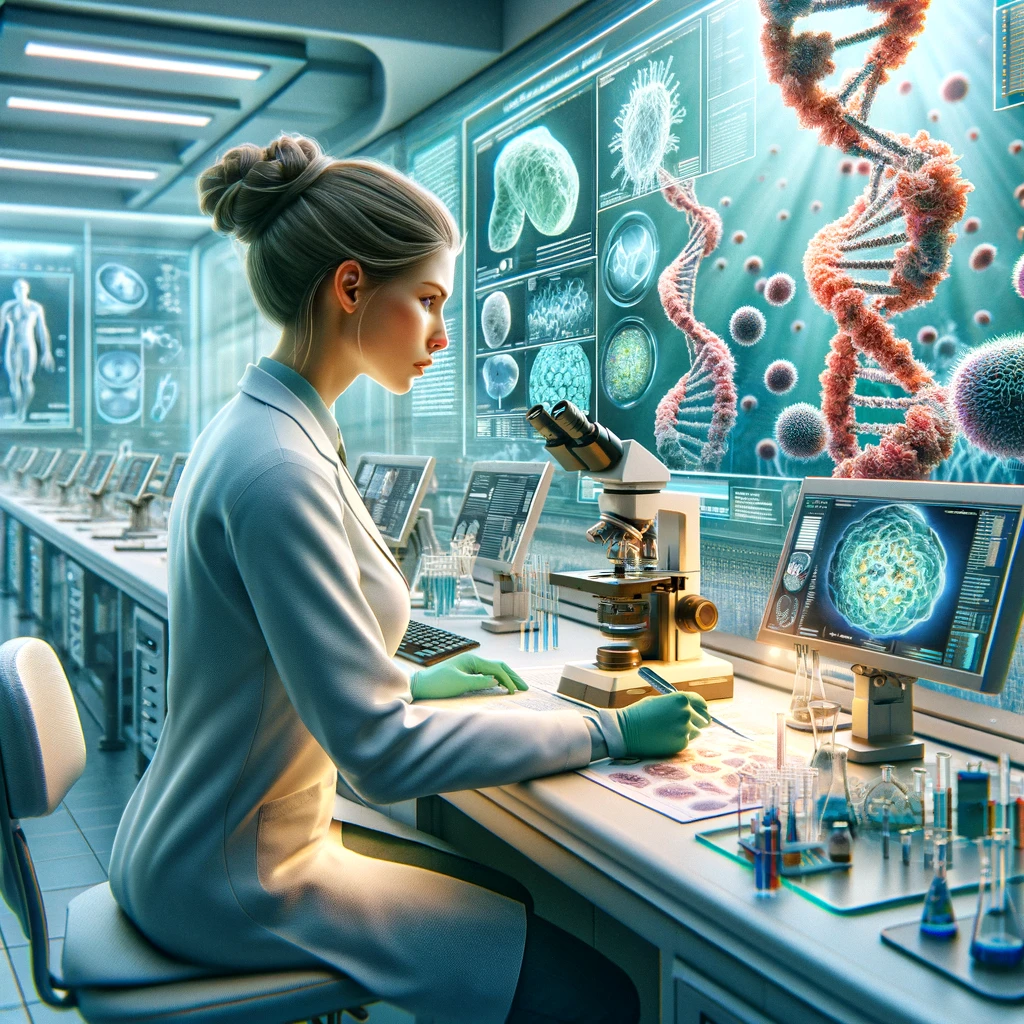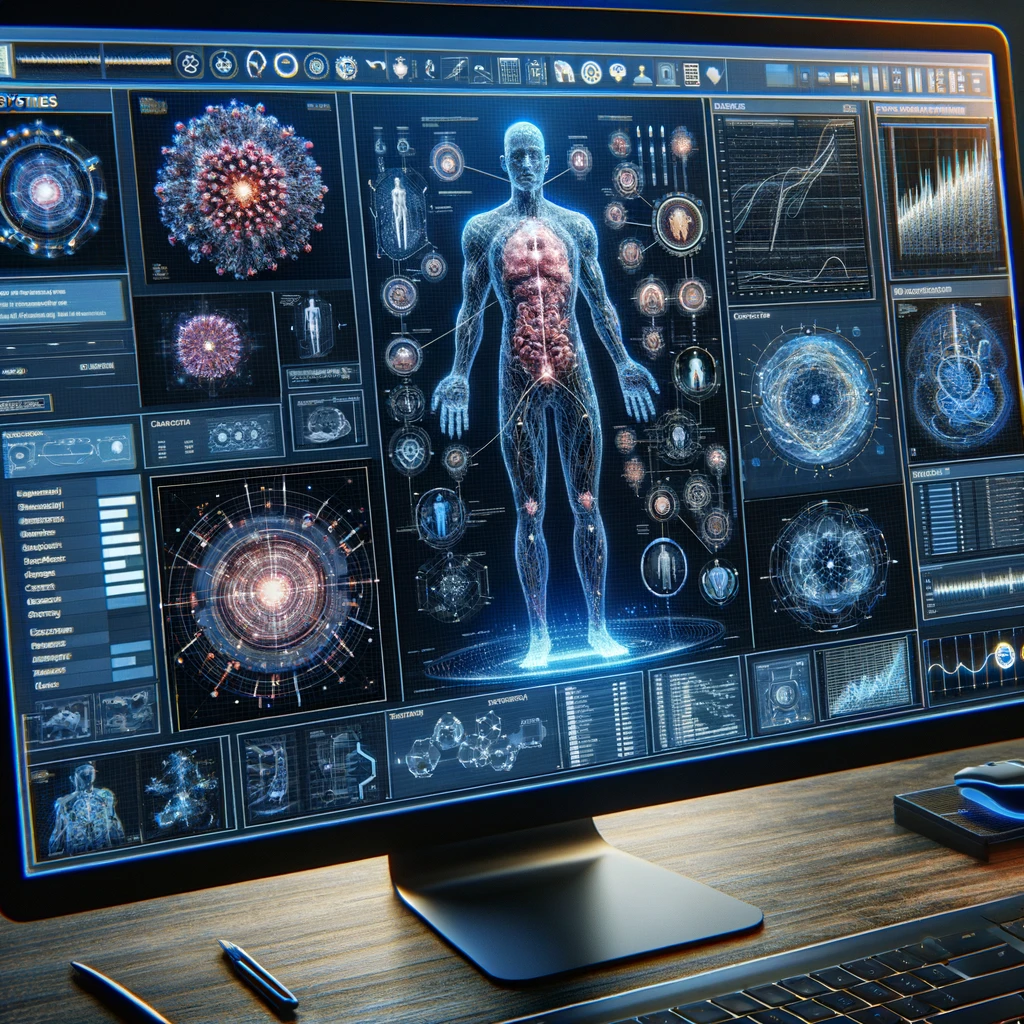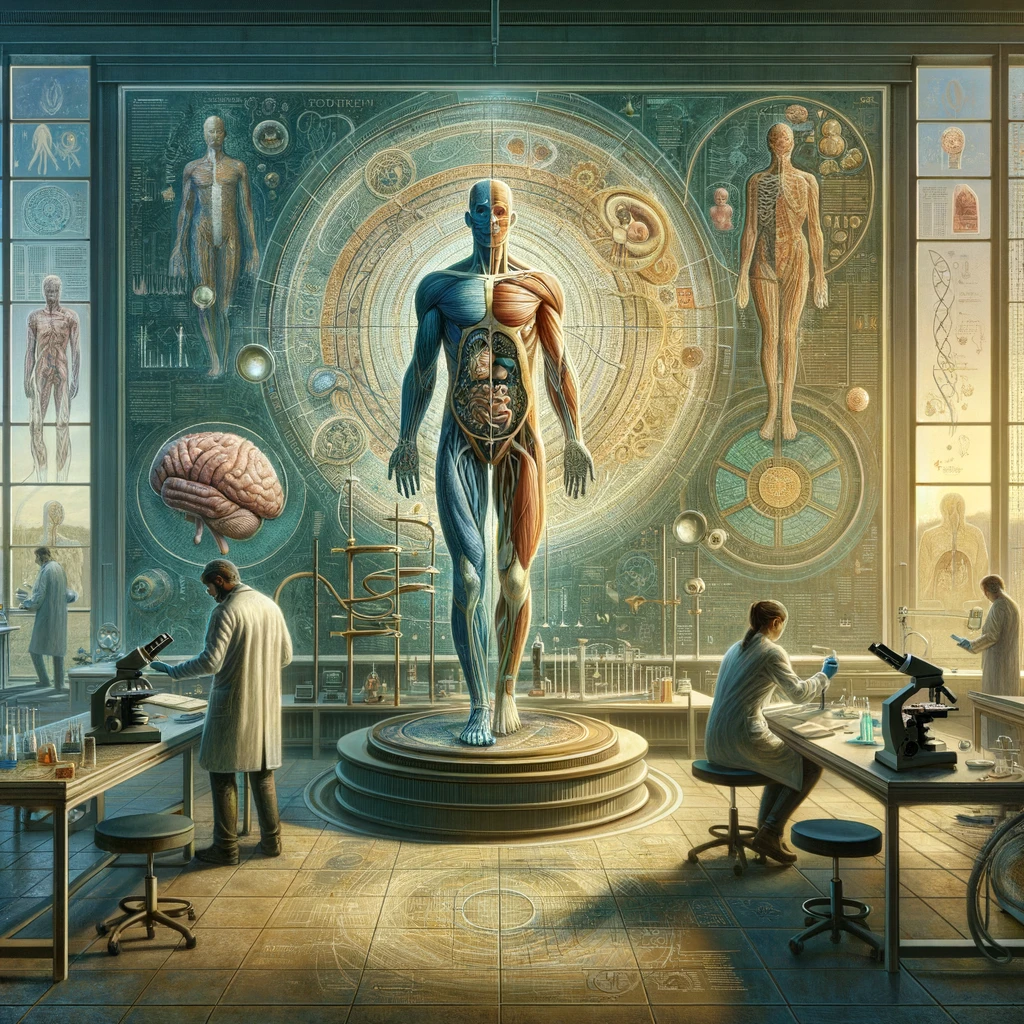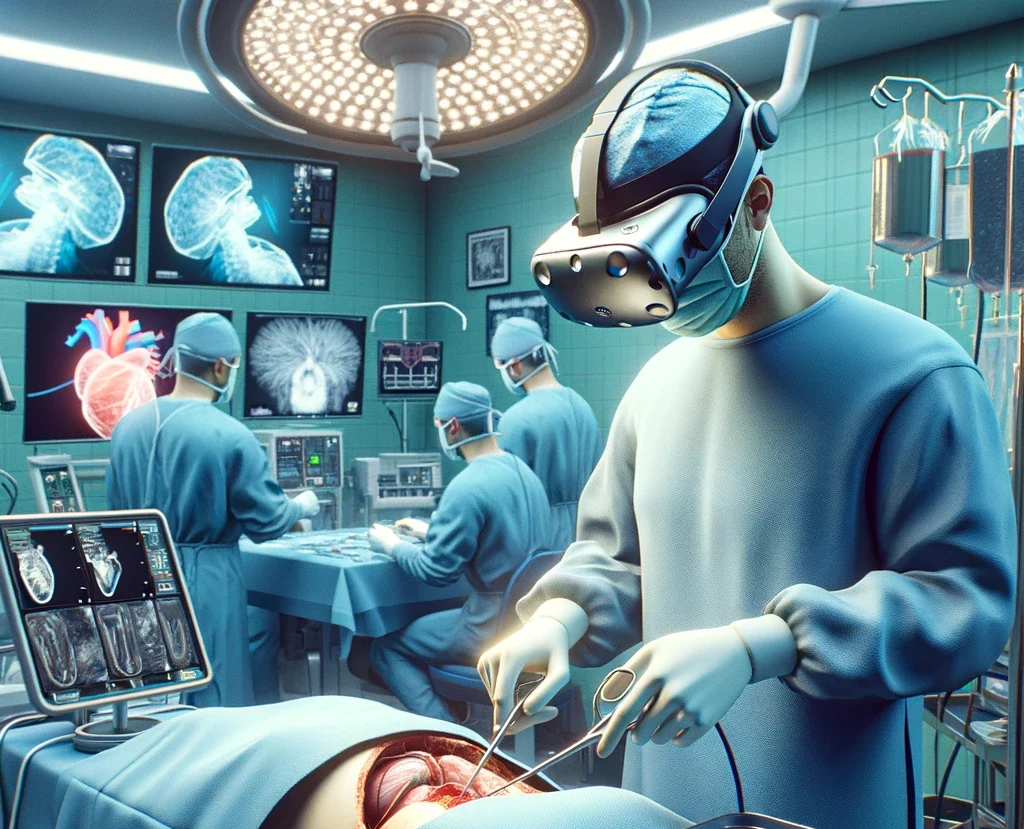The Human Body as a Complex System
Please note that most pictures on this page are AI generated and are not to be taken as accurate depictions of the subject matter.

Researching and learning about good health practices significantly impacts an individual’s likelihood of making better health choices. This is supported by studies that demonstrate the effectiveness of health education programs in facilitating behavior change and improving health outcomes.
The Transtheoretical Model of Health Behavior Change highlights that health behavior change involves progress through six stages: precontemplation, contemplation, preparation, action, maintenance, and termination. This model suggests that individualized, stage-matched interventions can dramatically improve recruitment, retention, and progress in health behavior change programs, highlighting the importance of personalized health education (Prochaska & Velicer, 1997).
Know Your Body Program, designed for middle school students, emphasizes personalized student involvement in health decision-making processes, demonstrating that early education on behavior patterns for healthier lifestyles can have a lasting impact (Carter, Eng, & Williams, 1980).
Health Education for Social Change argues for involving people in collective action to create health-promoting environments and lifestyles. This approach shifts the focus from individual behavior change to community-oriented models, suggesting that health education that fosters community involvement can lead to more sustainable health behavior changes (Freudenberg, 1978).
A Systematic Review of Patient Education in Cardiac Patients found that educational interventions were significantly and positively related to physical activity, dietary habits, and smoking cessation, demonstrating that health education can effectively increase patients’ knowledge and promote health behavior change in chronic disease management (Ghisi et al., 2014).
These studies underscore the critical role of health education in empowering individuals with the knowledge and skills necessary to make informed health decisions. By providing tailored information and engaging individuals in their health decision-making processes, health education programs can significantly influence positive health behavior changes, leading to improved health outcomes.

Understanding the human body from the perspective of quantum biology all the way through to the complete interactive functioning of organ systems offers a comprehensive insight into how life operates at every level of complexity. This knowledge is crucial for several reasons:
1. Quantum Biology:
Quantum biology explores the quantum underpinnings of biological processes. At this fundamental level, understanding how quantum mechanics influences enzymes, photosynthesis, and even the human sense of smell can reveal the efficiency and effectiveness of biological systems. It challenges and expands our understanding of life’s processes beyond classical physics, suggesting that quantum phenomena may play a significant role in biological functions that are yet to be fully understood.
2. Cellular Level:
At the cellular level, knowledge of how cells operate, communicate, and respond to their environment underpins all of biology and medicine. Cells are the basic units of life, and their functions—from DNA replication and protein synthesis to energy production and signal transduction—are critical for the survival and health of an organism. Understanding cellular processes is essential for diagnosing and treating diseases at their most fundamental level.
3. Tissue and Organ Level:
Tissues are groups of similar cells that perform specific functions. Understanding how different cell types are organized into tissues and how these tissues then form organs allows us to appreciate the specialization and coordination required for bodily functions. Each organ has a unique role, yet all work in concert to maintain homeostasis. Knowledge at this level is crucial for understanding organ function, the impact of diseases on specific organs, and for developing surgical and medical treatments.
4. Organ System Level:
Organ systems are groups of organs that work together to perform complex functions, like digestion, circulation, and reproduction. Understanding how these systems interact is essential for grasping the body’s holistic functioning. This knowledge helps in understanding systemic diseases (affecting multiple organ systems) and in designing interventions that consider the body as an integrated whole rather than as isolated parts.
5. Complete Interactive Functioning:
The human body is more than the sum of its parts. Its complete interactive functioning encompasses not only the physical interactions among cells, tissues, organs, and systems but also the integration with the mind and the environment. Understanding the body at this comprehensive level is crucial for approaches to health and disease that incorporate physical, psychological, and social well-being.
Benefits of This Multilevel Understanding:
Precision Medicine: Tailoring medical treatment to the individual characteristics of each patient requires an understanding of the human body from the quantum level to its complete interactive functioning. This approach can improve outcomes and minimize side effects.
Innovative Therapies: A deeper understanding of the body’s functioning can lead to the development of new therapies, such as those targeting specific molecular pathways, regenerative medicine techniques, or personalized drug formulations.
Preventive Health: Knowledge of how lifestyle factors and the environment interact with biological systems enables the development of effective preventive health measures, promoting longevity and reducing the incidence of chronic diseases.
Educational and Research Advancements: This comprehensive understanding fuels educational curricula that produce well-rounded healthcare professionals and researchers capable of pushing the boundaries of what is known about the human body and health.
In essence, knowing and understanding the human body at all these levels enriches our comprehension of life itself, enabling advancements in healthcare, improving patient outcomes, and fostering a holistic view of human health that integrates physical, mental, and environmental well-being.
The Human Cell

The human cell is an incredibly complex and dynamic unit that serves as the foundational building block of the human body. Each cell is a microcosm of life, performing a multitude of functions necessary for survival, growth, and reproduction. Here’s an overview of the human cell and its key functions:
Basic Structure
- Cell Membrane (Plasma Membrane): A lipid bilayer that encloses the cell, controlling the movement of substances in and out of the cell. It plays a critical role in cell communication and signaling.
- Cytoplasm: The jelly-like substance within the cell membrane, containing organelles and the cytoskeleton. It’s where many cellular processes occur.
- Nucleus: The control center of the cell, housing DNA and directing cell growth, metabolism, and reproduction. It contains the nucleolus, where ribosomal RNA is produced.
- Mitochondria: Known as the powerhouses of the cell, mitochondria generate ATP through cellular respiration, supplying energy for the cell.
- Ribosomes: Sites of protein synthesis, either floating freely in the cytoplasm or attached to the endoplasmic reticulum.
- Endoplasmic Reticulum (ER): A network of membranes involved in protein and lipid synthesis. The rough ER is studded with ribosomes, while the smooth ER lacks them and is involved in lipid synthesis.
- Golgi Apparatus: Modifies, sorts, and packages proteins and lipids for storage or transport out of the cell.
- Lysosomes: Contain enzymes that break down waste materials and cellular debris.
- Cytoskeleton: A network of fibers that maintains cell shape, secures some organelles in specific positions, allows cytoplasm and vesicles to move within the cell, and enables unicellular organisms to move independently.
Key Functions
- Energy Production: Through cellular respiration, cells convert glucose and oxygen into ATP, the energy currency of the cell.
- Protein Synthesis: Cells produce proteins that are essential for structure, function, and regulation of the body’s tissues and organs.
- Replication and Division: Cells replicate their DNA and divide through processes like mitosis and meiosis, ensuring growth, repair, and reproduction.
- Communication: Cells communicate with each other through chemical signals (hormones, neurotransmitters) and direct physical contact, crucial for coordinating bodily functions.
- Metabolism: Encompasses all chemical reactions within a cell, including breaking down nutrients to generate energy and synthesizing necessary compounds like proteins and lipids.
- Detoxification: Cells neutralize toxins through enzymes, particularly in the liver, protecting the body from harm.
Importance of Understanding Cell Functions
Understanding cellular functions is fundamental to biology and medicine, offering insights into how organisms grow, how the body repairs itself, and how diseases like cancer arise from cellular dysfunction. This knowledge is crucial for developing medical treatments, understanding genetic disorders, and advancing biotechnology.
In summary, the human cell is a marvel of biological engineering, performing an array of complex and interrelated functions that sustain life. Its study not only fascinates from a scientific perspective but also holds the key to unlocking new medical therapies and understanding the molecular basis of life itself.
The systems within the body

The human body is an intricate system comprised of several subsystems that work together to maintain overall health and functionality. Here’s a summary of the major systems that make up the complete system of the human body:
Skeletal System: Provides structure to the body, protects internal organs, and supports the attachment of muscles. It is composed of bones, cartilage, ligaments, and joints.
Muscular System: Consists of skeletal, smooth, and cardiac muscles. It facilitates movement of the body and its parts, maintains posture, and produces heat.
Circulatory System (Cardiovascular System): Comprises the heart, blood, and blood vessels. It transports oxygen, nutrients, hormones, and waste products throughout the body.
Nervous System: Includes the brain, spinal cord, and nerves. It controls both voluntary and involuntary responses and transmits signals between different parts of the body.
Respiratory System: Made up of the lungs and air passages. It is responsible for the exchange of oxygen and carbon dioxide between the body and the environment.
Digestive System: Encompasses the mouth, esophagus, stomach, intestines, liver, pancreas, and gallbladder. It breaks down food, absorbs nutrients, and eliminates waste.
Excretory System (Urinary System): Consists of the kidneys, ureters, bladder, and urethra. It removes waste from the blood and regulates water and electrolyte balance.
Endocrine System: Composed of glands that secrete hormones. It regulates metabolism, growth, reproduction, and other important bodily functions.
Reproductive System: In males, it includes the testes, sperm ducts, prostate gland, and penis. In females, it comprises the ovaries, fallopian tubes, uterus, and vagina. It is responsible for producing gametes and facilitating reproduction.
Immune System: A complex network of cells, tissues, and organs that work together to defend the body against pathogens, such as bacteria, viruses, and foreign bodies.
Integumentary System: Consists of the skin, hair, nails, sweat, and oil glands. It protects the body from external damage, regulates temperature, and facilitates sensation.
Lymphatic System: Includes lymph nodes, lymph vessels, and lymph. It helps protect and maintain the fluid environment of the body by filtering and draining lymph away from each region of the body.
Sensory Systems: Part of the nervous system, including the visual (eyes), auditory (ears), gustatory (tongue), olfactory (nose), and tactile (skin) senses. These systems enable perception of the environment and bodily responses to external stimuli.
Each of these systems plays a vital role in maintaining the health and functionality of the body, demonstrating the complexity and intricacy of human biology.
The functioning of the systems together

The human body is a complex and intricate network of systems, each with its unique functions but all working together in harmony to maintain homeostasis and support life. An overview of how these systems interact can highlight the remarkable coordination necessary for everyday functioning and health.
1. Circulatory System
The circulatory system, including the heart, blood, and blood vessels, distributes oxygen, nutrients, hormones, and other substances to tissues throughout the body. It also plays a crucial role in removing metabolic wastes. The circulatory system works closely with the respiratory system to exchange carbon dioxide for oxygen in the lungs.
2. Respiratory System
The respiratory system, consisting of the lungs, airways, and respiratory muscles, facilitates the exchange of oxygen and carbon dioxide between the air and the bloodstream. This system works closely with the circulatory system to circulate oxygen-rich blood to all parts of the body and remove carbon dioxide, a waste product of metabolism.
3. Digestive System
The digestive system breaks down food into nutrients, which are absorbed into the bloodstream and transported to cells for energy, growth, and repair. The liver, part of the digestive system, also plays a critical role in detoxifying harmful substances, metabolizing drugs, and producing biochemicals necessary for digestion.
4. Urinary System
The urinary system, including the kidneys, ureters, bladder, and urethra, removes waste products from the circulation and regulates blood volume, electrolytes, and pH balance. The kidneys filter blood to produce urine, which carries waste products out of the body.
5. Musculoskeletal System
The musculoskeletal system provides structure and support to the body, enables movement through the skeletal muscles, and protects internal organs. Bones produce blood cells and store minerals, while joints and connective tissues enable flexibility and mobility.
6. Nervous System
The nervous system, including the brain, spinal cord, and peripheral nerves, controls body movements, responds to sensory information, and helps regulate all other body systems. It communicates signals between the brain and the rest of the body and is involved in everything from maintaining homeostasis to processing complex thoughts and emotions.
7. Endocrine System
The endocrine system, comprising glands that secrete hormones, regulates metabolism, growth, reproduction, and stress responses. Hormones act as chemical messengers that influence or control the function of other cells or organs throughout the body.
8. Immune System
The immune system defends the body against infectious agents and other foreign invaders. It includes lymph nodes, the spleen, bone marrow, and white blood cells, among other components. The immune system works closely with the circulatory system to detect and respond to pathogens.
9. Integumentary System
The integumentary system, consisting of the skin, hair, nails, and exocrine glands, protects the body from external threats, helps regulate body temperature, and enables sensory perception.
10. Lymphatic System
The lymphatic system helps protect and maintain the fluid environment of the body by filtering and draining lymph, a fluid containing white blood cells and waste products, away from tissues and back into the circulatory system.
11. Reproductive System
The reproductive system enables the production of offspring and the continuation of genetic material. In females, it involves the production of eggs, and in males, the production of sperm. Hormones from the endocrine system regulate the development and function of the reproductive system.
In summary, the systems of the body are interconnected and interdependent, with each playing a role in maintaining the health and functionality of the organism. Their interactions facilitate complex processes such as growth, energy production, reproduction, and adaptation to environmental changes, illustrating the body’s remarkable ability to function as a cohesive and dynamic whole.

Macronutrients are the nutrients required by the body in large amounts to provide energy and support overall health and bodily functions. They include carbohydrates, proteins, and fats, each playing unique roles in the body:
1. Carbohydrates
Carbohydrates are the body’s primary energy source. They are found in foods like fruits, vegetables, grains, and dairy products, and are broken down into glucose, which the body uses for energy. Carbohydrates can be classified into two main types:
- Simple carbohydrates (sugars) provide quick energy but can lead to spikes in blood sugar levels.
- Complex carbohydrates (starches and fiber) are digested more slowly, providing a more sustained energy release and helping with digestive health.
2. Proteins
Proteins are essential for building, repairing, and maintaining tissues in the body, including muscles, skin, and organs. They are also crucial for producing enzymes, hormones, and other biochemicals. Dietary proteins are made up of amino acids, nine of which are considered essential because the body cannot synthesize them and they must be obtained through the diet. Sources of protein include meat, fish, dairy, legumes, and some grains.
3. Fats
Fats are a concentrated source of energy, providing more than double the energy per gram compared to carbohydrates and proteins. They are vital for absorbing fat-soluble vitamins (A, D, E, and K), protecting organs, and maintaining cell membranes. Fats can be categorized into:
- Saturated fats: Typically solid at room temperature, found in animal products and some plant oils. High intake is associated with increased risk of heart disease.
- Unsaturated fats: Liquid at room temperature and generally considered healthier. They are found in foods like nuts, seeds, fish, and vegetable oils. Unsaturated fats can be further divided into monounsaturated and polyunsaturated fats, which include omega-3 and omega-6 fatty acids, beneficial for heart health.
4. Water
Though not always classified as a macronutrient, water is essential for life and is required in large amounts. It plays key roles in cellular processes, temperature regulation, nutrient transport, and waste elimination.
Dietary Recommendations
A balanced diet includes an appropriate intake of all three macronutrients, tailored to an individual’s energy needs, health status, and activity level. The distribution of macronutrients can vary depending on dietary patterns and goals, but general guidelines suggest a balance that supports overall health and well-being, with attention to the quality and sources of these nutrients.

Micronutrients are essential vitamins and minerals that the body requires in small amounts to function properly and maintain health. Unlike macronutrients, which are needed in larger quantities, micronutrients are needed in smaller amounts but are crucial for development, disease prevention, and the overall well-being of the body. Micronutrients can be broadly categorized into two groups:
Vitamins
Vitamins are organic compounds that are necessary for various metabolic processes and must be obtained through the diet, as the body cannot produce them in sufficient quantities. They can be divided into two types based on their solubility:
Fat-soluble vitamins: These vitamins are stored in the body’s fatty tissue and the liver. They include:
- Vitamin A (Retinol) – important for vision, immune function, and skin health.
- Vitamin D – essential for bone health, immune function, and calcium absorption.
- Vitamin E (Tocopherol) – acts as an antioxidant, protecting cells from damage.
- Vitamin K – necessary for blood clotting and bone metabolism.
Water-soluble vitamins: These vitamins are not stored in the body and must be consumed more regularly. They include:
- Vitamin C (Ascorbic acid) – important for the immune system, skin health, and antioxidant function.
- B-vitamins: This group includes B1 (Thiamine), B2 (Riboflavin), B3 (Niacin), B5 (Pantothenic acid), B6 (Pyridoxine), B7 (Biotin), B9 (Folate or Folic acid), and B12 (Cobalamin). They are essential for energy production, DNA synthesis, and the maintenance of healthy nerve cells.
Minerals
Minerals are inorganic elements that also play a key role in various bodily functions, including bone formation, heartbeat regulation, and the production of hormones. They are categorized as:
Macro-minerals: Required in larger amounts than trace minerals. They include:
- Calcium – crucial for bone health and muscle function.
- Phosphorus – important for bone and teeth formation, as well as energy production.
- Magnesium – involved in over 300 enzymatic reactions, including muscle and nerve function.
- Sodium – essential for fluid balance and nerve transmission.
- Potassium – helps maintain normal blood pressure and muscle contractions.
- Chloride – important for fluid balance and stomach acid production.
- Sulfur – a component of some amino acids and vitamins.
Trace Minerals: Needed in smaller amounts but equally important for health. They include:
- Iron – essential for the production of hemoglobin, which carries oxygen in the blood.
- Zinc – plays a role in immune function, wound healing, and DNA synthesis.
- Copper – important for iron metabolism and the production of red blood cells.
- Manganese – involved in the metabolism of amino acids, cholesterol, glucose, and carbohydrates.
- Selenium – has antioxidant properties and helps prevent cellular damage.
- Fluoride – important for the development of bones and teeth.
- Iodine – essential for thyroid gland function and the production of thyroid hormones.
- Chromium – involved in macronutrient metabolism and blood sugar regulation.
- Molybdenum – plays a role in the metabolism of sulfur-containing amino acids.
Adequate intake of these micronutrients through a balanced diet is essential for good health, preventing deficiencies that can lead to various health issues.
Poor inputs equal poor outputs

A poor diet, characterized by insufficient intake of healthy foods, negatively impacts human health in several critical ways:
Nutrient Deficiencies: Not consuming a balanced diet can lead to deficiencies in essential nutrients, including vitamins, minerals, and dietary fiber. This can cause a variety of health issues, such as anemia (due to a lack of iron), scurvy (due to a lack of vitamin C), and rickets (due to a lack of vitamin D and calcium).
Gut Health Disruption: A diet low in fiber affects gut health by altering the composition of the gut microbiota. This can lead to digestive problems, including constipation, and may increase the risk of developing gastrointestinal diseases such as colorectal cancer.
Increased Risk of Chronic Diseases: Poor dietary habits, such as high intake of saturated and trans fats, salt, and sugars, are linked to an increased risk of developing chronic diseases, including cardiovascular diseases, hypertension, diabetes, and certain cancers.
Obesity and Weight Gain: Consuming high-calorie, nutrient-poor foods can lead to excessive weight gain and obesity, which are risk factors for many health conditions, including heart disease, diabetes, and joint problems.
Impact on Mental Health: Emerging evidence suggests that a poor diet may be linked to an increased risk of developing mental health disorders, such as depression and anxiety. Nutrient deficiencies and the impact of diet on gut health can influence brain function and mood.
Compromised Immune Function: A diet lacking in essential nutrients can weaken the immune system, making the body more susceptible to infections and illnesses.
Poor Bone Health: Inadequate intake of calcium and vitamin D can lead to poor bone health, increasing the risk of osteoporosis and fractures.
Impact on Cognitive Function: Diet influences brain health and cognitive function. Poor nutrition can impair cognitive development in children and increase the risk of cognitive decline and neurodegenerative diseases in adults.
To mitigate these risks, it’s essential to adopt a balanced diet rich in fruits, vegetables, whole grains, lean proteins, and healthy fats, which provide a wide range of nutrients necessary for maintaining good health.
Unhealthy Eating

A poor diet, characterized by insufficient intake of healthy foods, significantly impacts human health in various adverse ways, as supported by numerous studies:
Cardiovascular Disease, Diabetes, and Obesity: Suboptimal nutrition is a leading cause of poor health, directly linked to cardiovascular diseases, obesity, and diabetes mellitus. Increasing intake of fruits, vegetables, nuts, and whole grains while reducing consumption of red meats, processed meats, and foods high in refined grains and sugars is crucial for mitigating these risks (Mozaffarian, 2016).
Gut Microbiota and Health: The diet profoundly affects the gut microbiota, which in turn impacts metabolic conditions such as obesity and type 2 diabetes. Dietary nutrients are vital for the health of the gut microbiome, influencing human physiology and potentially underlying broader effects of diet on health (Gentile & Weir, 2018).
Socioeconomic Inequalities in Diet Quality: Poor diet is not only a health issue but also a matter of socioeconomic inequality, contributing to a burden of disease across different demographics. Addressing these inequalities requires interventions at individual, community, and societal levels (Peeters & Blake, 2016).
Environmental and Chronic Disease Links: The global dietary transition towards high intake of refined sugars and fats increases the risk of chronic diseases and has environmental implications, suggesting the need for alternative diets that offer health benefits while reducing environmental impacts (Tilman & Clark, 2014).
Impact on Immune Function: The Western diet, characterized by overconsumption of sugars, salt, and saturated fat, impacts immune function, leading to increased inflammation, reduced infection control, and higher rates of cancer and autoimmune diseases (Myles, 2014).
These findings highlight the critical role of diet in influencing health outcomes and the need for comprehensive strategies to promote healthier eating patterns to prevent diet-related non-communicable diseases.

